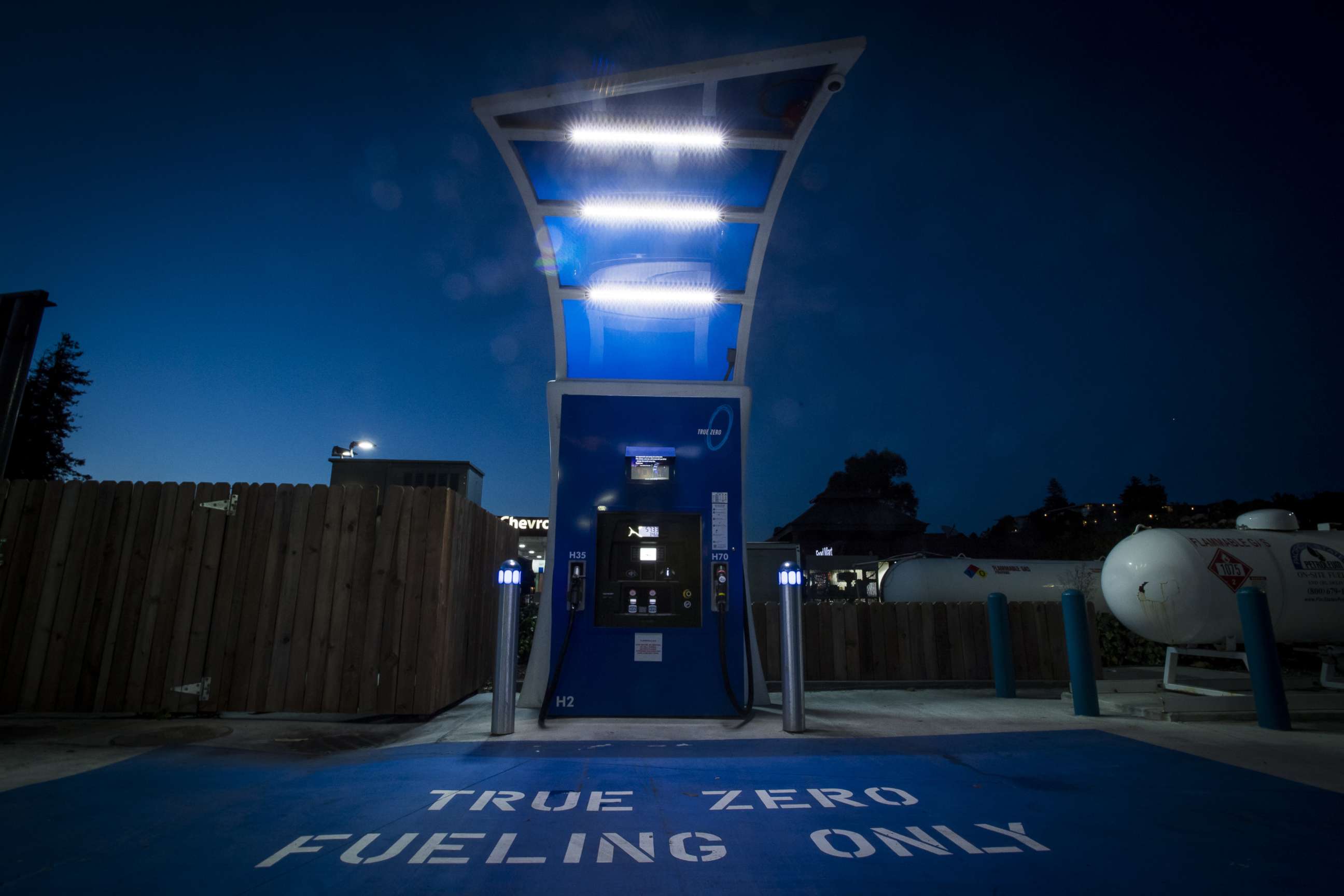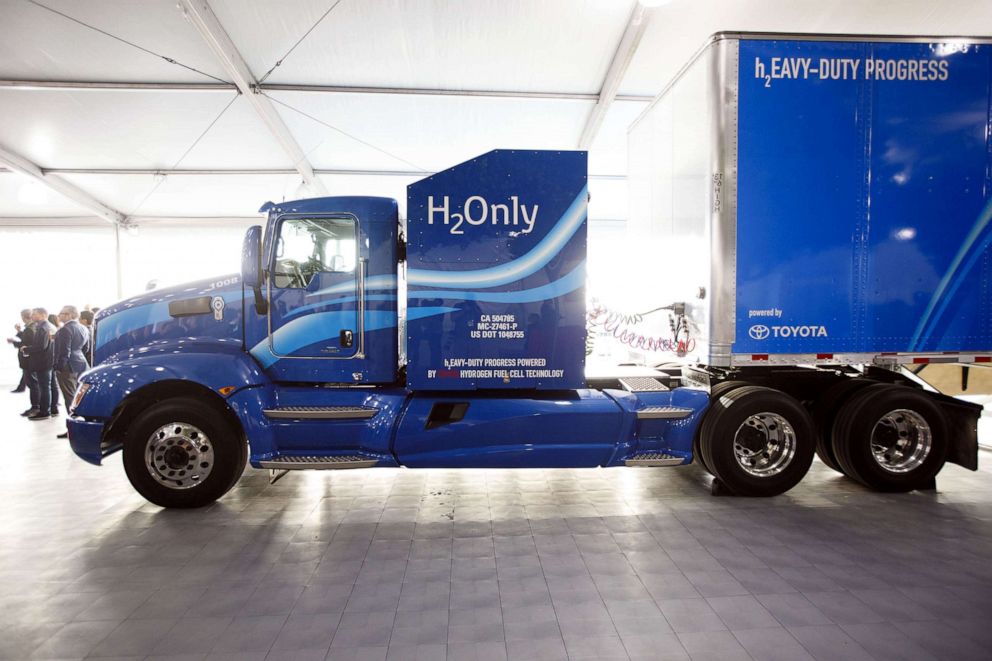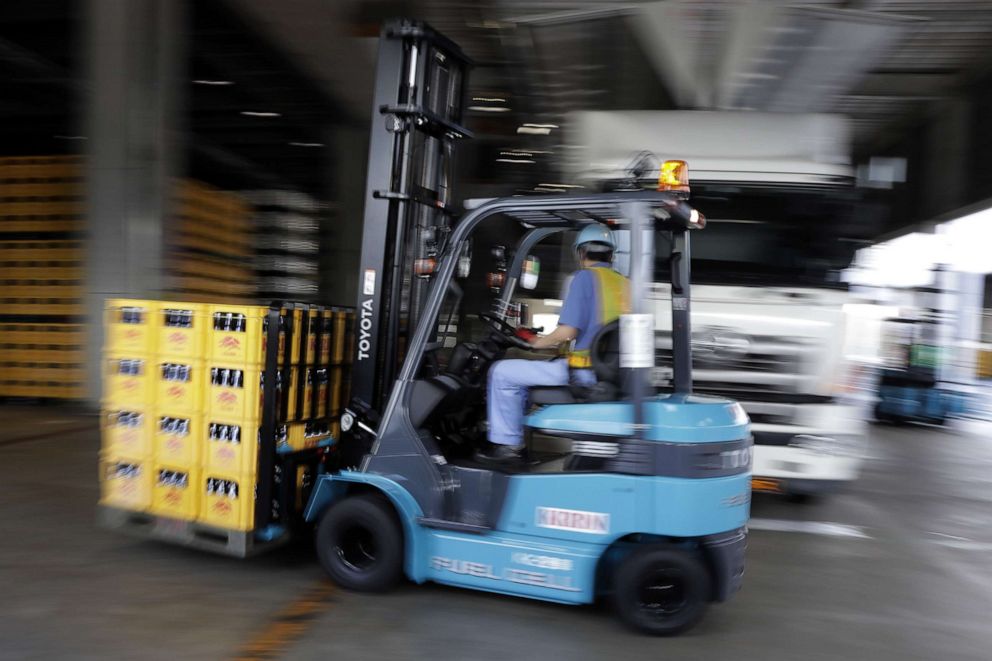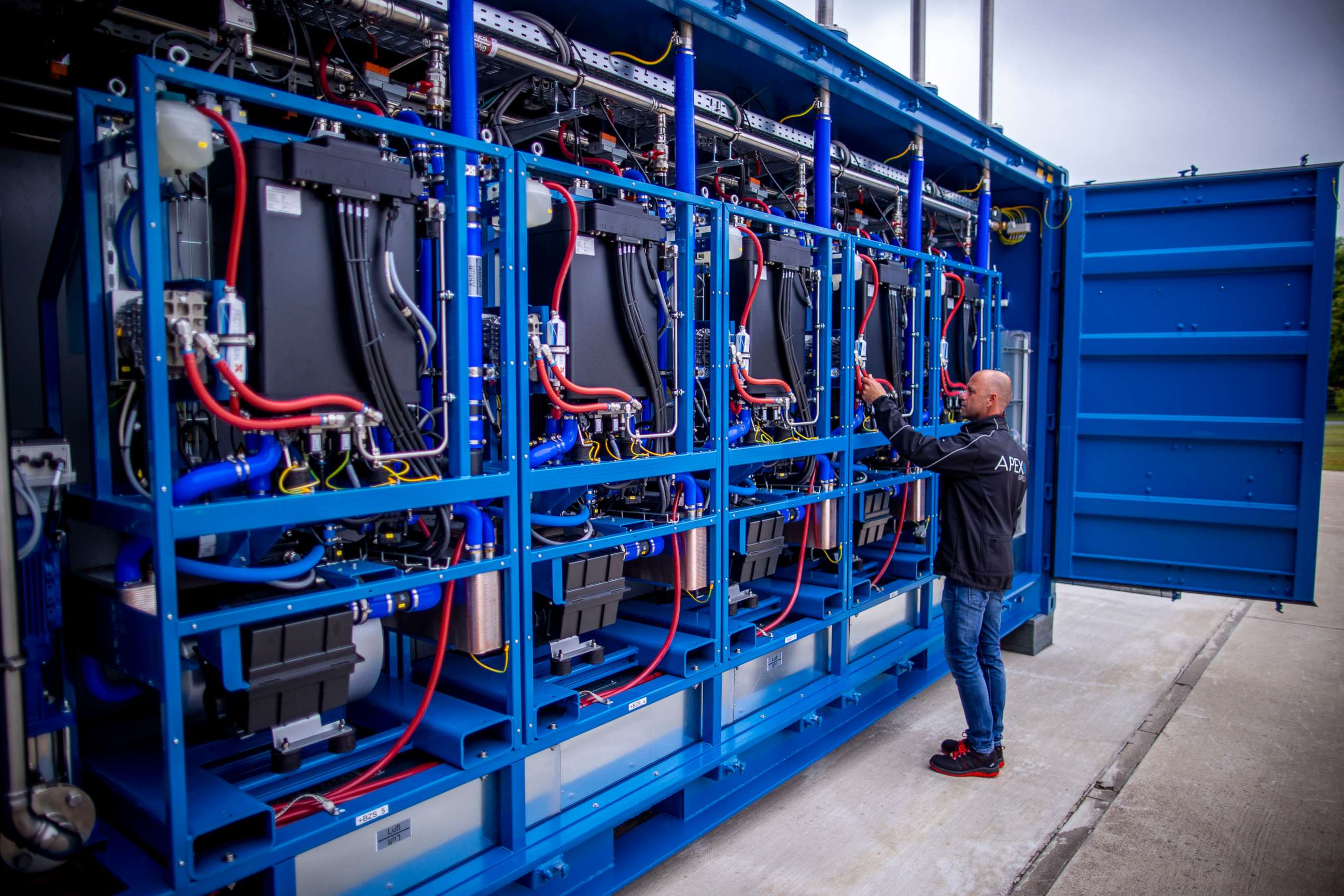Why green hydrogen is the renewable energy source to watch in 2021
The price tag and energy needed to make it will be worth it, experts say
Green hydrogen, an alternative fuel generated with clean energy, is experiencing a global resurgence and has been identified as the clean energy source that could help bring the world to net-zero emissions in the coming decades.
It was initially touted in the U.S. during President George W. Bush's first term, when it was nicknamed the "freedom fuel."
Now, President-elect Joe Biden is promising that the U.S. will be able to access green hydrogen at the same cost as conventional hydrogen within a decade as part of his clean energy plan. Several countries around the world already invest heavily into it, including Chile, Japan, Saudi Arabia, Germany and Australia.
The market for green hydrogen is expected to grow exponentially in the coming decade, experts told ABC News.
"It puts the spotlight on [hydrogen] gas for the first time," a study published in Nature in July stated. "And the gas industry is turning to hydrogen for a new lease of life."
However, the disadvantages of green hydrogen may be equal to its advantages, Bloomberg New Energy Finance analyst Michael Liebreich wrote in an essay published in October.
Bloomberg NEF estimates that an $11 trillion investment in production and storage worldwide through 2050 and more electricity than the world generates now to have green hydrogen meet a quarter of the world's energy needs. In addition, it carries one quarter the amount of energy per unit compared to natural gas, can embrittle metal and is highly combustible, Liebreich wrote.
In addition, the current investment and production are not forecast to keep up with demand. Current projects are only expected to generate 3 million tons a year, compared to a global target of 8.7 million tons per year, a report published in August by the Institute for Energy Economics and Financial Analysis found.
ABC News spoke to experts to determine whether, given the cost and energy required to make it, green hydrogen is worth the hype.

Why green hydrogen?
Green hydrogen solves "a number of problems" when trying to de-carbonize the energy and industrial sectors, Randy Bell, director of the Global Energy Center at the Atlantic Council, a nonpartisan think tank, told ABC News.
What makes hydrogen clean depends on how it's made.
The vast majority of the hydrogen used today, "gray" hydrogen, is produced using fossil fuels, emitting carbon dioxide in the process. "Blue" hydrogen is made using natural gas and then capturing the carbon dioxide emissions, making it cleaner than gray hydrogen.
However, carbon-free "green" hydrogen is made using electricity to split the hydrogen molecules from oxygen molecules in water. The byproduct after hydrogen combustion is not carbon dioxide, but rather water.
The key is having an abundance of cheap low-carbon electricity, sourced from wind or the sun, Julio Friedmann, senior research scholar at the Center on Global Energy Policy at Columbia University, told ABC News
Green hydrogen is forecast to fill 15% to 20% of the world's energy needs that will not be easily met with battery, wind or solar power, Gregory Nemet, professor of public affairs at the University of Wisconsin's Energy Institute, told ABC News.
"Hydrogen is a good option for things you can’t electrify, can’t readily place," Friedmann said. "That’s an important thing."

How green hydrogen compares with other forms of clean energy
David Yellen, program assistant for the Global Energy Center at the Atlantic Council, called green hydrogen the "Swiss Army knife" of the transition to clean energy.
The last decade has seen "amazing cost reductions" in solar and wind power and especially in batteries, Nemet said.
But those energy sources won't do well for heavy manufacturing, long-distance transport such as trucking, cargo ships and aircraft, so green hydrogen, with its high-energy density, is expected to fill the gaps.
For example, the weight of a battery is an issue for air travel. Jet fuel burns as it goes, but batteries stay the same weight throughout the trip, Nemet said.
Also, the space batteries take up make them problematic for trucks, Friedmann said, while hydrogen can be used in steel mills due to its ability to produce high-quality heat and in the form of ammonia on ships (which serves as fuel).
Hydrogen also beats batteries for long-term storage, Bell said.
"For this big investment for hydrogen to pay off, it's always going to have to compete with batteries," he added.
Solutions need to be found for safely storying hydrogen on aircraft and building infrastructure for the alternative fuel at airports, said European airplane manufacturer Airbus in a statement in October. Despite those challenges, the company still believes green hydrogen will play a significant role in decreasing emissions from air travel.

Green hydrogen can use existing infrastructure
One of the reasons why there is so much interest and enthusiasm surrounding green hydrogen is that the infrastructure already exists for it, Friedmann said.
Because of the way green hydrogen is produced, it likely won't be used where it is made, Nemet said. Therefore, it will need to be pressurized and then moved, either through a pipeline, ship or truck using the existing infrastructure in place.
With hydrogen, at about a 10% ratio, it's possible "to just throw into natural gas pipelines today, and it does OK," Friedmann said.
The refineries that exist that use gray hydrogen to make chemicals can also do so using green hydrogen, Nemet said, and it also is compatible with existing industrial machinery in a lot of cases, Yellen said.
In addition, a lot of the engines on long-haul trucks can run on hydrogen, but eventually they will need to be replaced with hydrogen fuel cells, which are expensive, Friedmann said.
Another benefit of green hydrogen is it can be blended into natural gas, Friedmann said.

The price tag will be worth it, experts say
Nemet described the $11 trillion estimated investment for green hydrogen as quite a large number but pointed out that it's over 30 years and essential to getting the world to net-zero emissions by mid-century.
"The energy sector is big," he said. "$11 trillion over 30 years is a big number, but in terms of the whole energy system, it’s not shockingly big."
Experts said the large cost comes from three parts: the electricity used to make the hydrogen and building solar panels and wind turbines to do it cleanly accounts for more than half; the electrolyzers, the machines that produce the large amounts of electricity and the transport, such as pipelines and shipping, account for the rest.
It's "not helpful" to think of the cost of green hydrogen "as an energy return on investment" when it's so essential for the world to get to net-zero emissions and fast, Friedmann said, adding that in order to "get money back," hydrogen will have to be used a lot.
"The question is how much can we make and how much does it cost," he said. "And now it's looking interesting."
Another aspect of the investment cost is the jobs the green hydrogen transition will create. It may be hard to see how companies can make a profit now, Yellen said, but in the short term it "helps keep a number of people who are in a hydrocarbon industry employed."
People also need to think about the community benefits the making of green hydrogen can bring, such as replacing diesel in trucks and the improvement that will have on local air quality, especially in large shipping hubs.

The U.S. has some catching up to do
While the experts say the U.S. is lagging behind in green hydrogen investment, new projects are underway, especially in California, where officials are pushing aggressively toward a carbon-neutral future.
The Golden State began pushing for vehicles to be fueled by green hydrogen -- and electricity -- since 2009, when it passed the Low Carbon Fuel Standard.
A green hydrogen power plant is currently being built in Delta, Utah, partly funded by the Los Angeles Department of Water and Power to produce energy for Southern California.
Energy company SGH2 is building a green hydrogen facility in Southern California that will produce it through waste gasification -- heating waste to high temperatures so that the broken down molecules bind with hydrogen -- instead of electrolysis, which is intended to be cheaper.
The City of Los Angeles is also blending about 4% of green hydrogen into natural gas pipelines with the ultimate goal to increasing to 10%, Friedmann said.
California is also looking to get a framework for the offshore wind coming from the Pacific to produce green hydrogen, and Houston could also become a demand center in the future due to its wind resources there, Bell said.
On a federal level, the U.S. Department of Energy announced in June that it will provide $100 million in funding to develop affordable electrolyzers to advance hydrogen and fuel cell technologies for long-haul trucks.
There are currently bipartisan bills being drafted in Washington D.C. for green hydrogen as well as a component in Biden's clean energy plan for industrial decarbonization and decreasing emissions from heavy industry, which is "where green hydrogen will be important," Friedmann said.
"And I think we're equally interested to see what role the Biden administration could play in encouraging those sort of local project developments," Yellen said.

The green hydrogen revolution has begun
The production of fossil fuels must be decreased by 6% per year between 2020 and 2030 in order to prevent a "catastrophic" global temperature rise, a report backed by the United Nations published earlier this month has found,
Countries around the world are making green hydrogen a priority for their energy needs, and a lot of the cost will be attributed to the country's natural resources, such as Chile, which is investing in hydrogen infrastructure due to its optimal wind resources, Yellemn said.
Saudi Arabia is building the largest green energy and ammonia plant in Neom, touted as the "city of the future." In July, the city and Saudi Arabian power company ACWA Power signed an agreement with U.S. chemical industry company Air Products to build the plant, which will be powered by wind and solar sources across the desert and is expected to propel Saudi Arabia toward a carbon-free future.
The European Union announced over the summer its intent to expand green hydrogen on a large scale as part of its $550 billion clean energy plan, which will include transport and storage as well as electrolyzers. In July, the Commission announced a hydrogen strategy that calls for a $430 billion investment in green hydrogen by 2030.
Hydrogen has been on Germany's radar since 2006, when the government began allocating large amounts of funding toward the project. In June, the country created a "package for the future," which made 7 billion euros available toward the rollout of green hydrogen in Germany and another 2 billion euros for international partnerships.
In October, Spain announced a project to launch four electrolyzers that will meet 20% of its green hydrogen goal by 2030. The country's has an ideal landscape and weather pattern for production by solar and wind.
One of the world's largest green hydrogen plants has recently opened near Fukushima, where a nuclear disaster that followed an earthquake and tsunami in 2011 occurred. Japan is already paying a premium for green hydrogen than regular hydrogen, Friedmann said. In October, Japan announced a goal of net-zero emissions by 2050.
The experts agree that the use of green hydrogen must be implemented if countries are to meet any of the climate pledges they have made in the Paris Agreement and beyond.
"By 2050, you just can't do it with renewables or with nuclear, or with energy efficiency alone," Bell said. "That combination just doesn't quite get you there."




